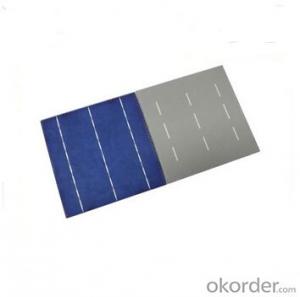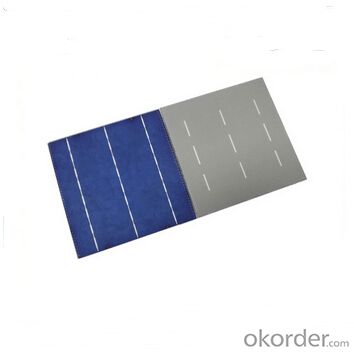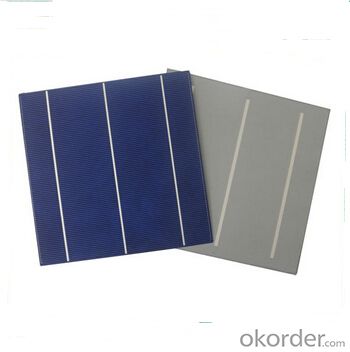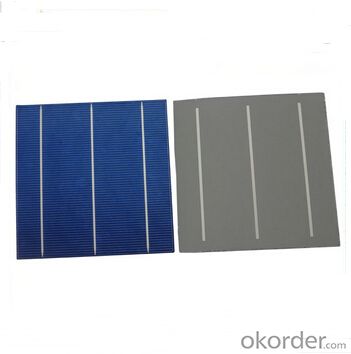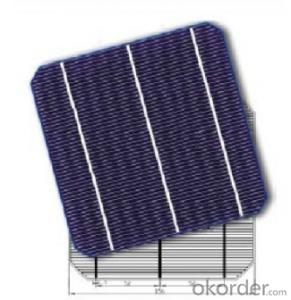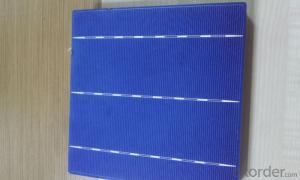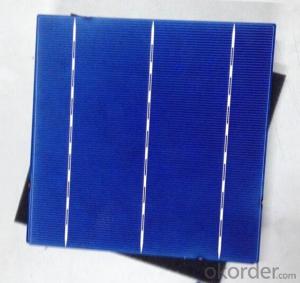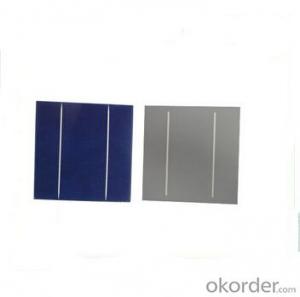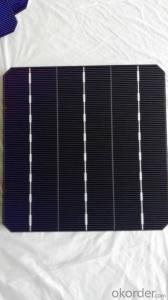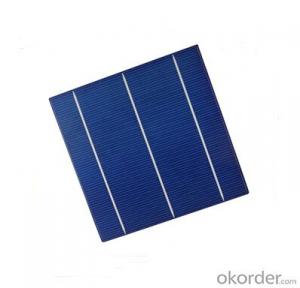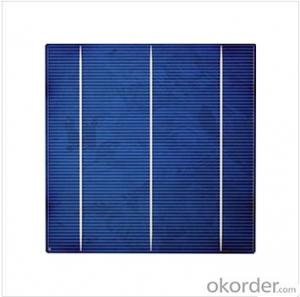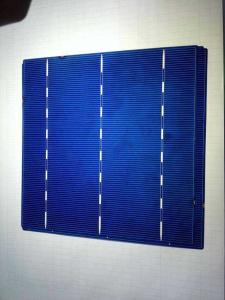Thin Film Photovoltaic Solar Cells - Polycrystalline Solar Cells Model:RSC-M156 Size:156mm
- Loading Port:
- Shanghai
- Payment Terms:
- TT or LC
- Min Order Qty:
- 3000 pc
- Supply Capability:
- 300000 pc/month
OKorder Service Pledge
OKorder Financial Service
You Might Also Like
Solar Cells:
Solar cells is made by solar wafer, it has three categories of solar cell right now, monocrystalline polycrystalline and thin film,These cells are entirely based around the concept PN junction, which is the critical part of solar module, it is the part that can convert the light energy into electricity, the thickness is from 180um to 200um, with even busbars to conduct electricity, textured cell can decrease diffuse reflection; they are often electrically connected and encapsulated as a module. Photovoltaic modules often have a sheet of glass on the front (sun up) side, allowing light to pass while protecting semiconductor wafers from abrasion and impact due to wind-driven debris, rain, hail, etc. Solar cells are also usually connected in series in modules, creating an additive voltage. Connecting cells in parallel will yield a higher current;With high quality and stable quality. Our Cells can greatly improve the performance of Solar Modules.
Features:
1. High conversion efficiencies resulting in superior power output performance.
2. Proven long term mechanical stability of silicon
3. Make of highly purified poly silicon
4. Three bus bars for reduced series resistance and improved module and cell efficiency
5. Blue anti-reflecting coating ensures improved light absorption and increased efficiency
6. Acid texturization offers a uniform appearance and virtually invisible crystal structure
Solar Cells Advantage:
1. Tire-1 Solar Cells’ Manufacturer Quality Guarantee. With a complete and sophisticated quality government system, our Quality Management have arrived world’s leading place. Customer can receive Tire-1 Cells Maker’s Quality Standard Products.
2. Trusted Warranty. We can supply trusted after-sales service to our customer. If our cells are found not in conformity to the specification of manufacturer, or should the inspected quantity found in shortage, or should the packing found damaged, the buyer has the right to claim to the seller. The claim, if any, should be presented to seller within 30 days after cargo's arrival date to the port, together with related inspection report and photos issued and provided by a reputable independent surveyor such as SGS.
3. World’s Leading Manufacturer Equipment. We imported the newest and leading production equipment from abroad. Advanced equipment can guarantee the stable quality of cells. Auto production line can also save labor cost which will further cut our production cost.
Specifications:
POLYCRYSTALLINE SOLAR CELLS
Model: RSC-M156
Size (MM): 156
Efficiency: up to 17.6%
MECHANICAL DIMENSION
Efficiency: up to 17.6%
Dimension: 156mm×156mm±0.5mm
Thickness: 200±20µm
TEMPERATURE COEFFICIEN
Power: - 0.460%/k
Current: + 0.031%/k
Voltage: - 0.348%/k
EFF | PPM | IPM | VMP | ISC | VOC |
≥18.% | 4.38W | 8.165A | 0.537V | 8.688A | 0.637V |
17.8%--18.0% | 4.33W | 8.127 | 0.534 | 8.651 | 0.636 |
17.7%--17.8% | 4.30W | 8.107 | 0.532 | 8.635 | 0.636 |
17.6%--17.7% | 4.28W | 8.087 | 0.531 | 8.619 | 0.634 |
17.5%--17.6% | 4.25W | 8.068 | 0.529 | 8.605 | 0.634 |
17.4%--17.5% | 4.23W | 8.049 | 0.527 | 8.591 | 0.633 |
17.2%--17.4% | 4.18W | 8.032 | 0.525 | 8.578 | 0.632 |
17.1%--17.2% | 4.16W | 8.004 | 0.522 | 8.555 | 0.63 |
17.0%--17.1% | 4.13W | 7.881 | 0.521 | 8.434 | 0.629 |
16.8%--17.0%. | 4.08W | 7.865 | 0.520 | 8.415 | 0.628 |
16.0%--16.8% | 3.9W | 7.426 | 0.516 | 8.012 | 0.625 |
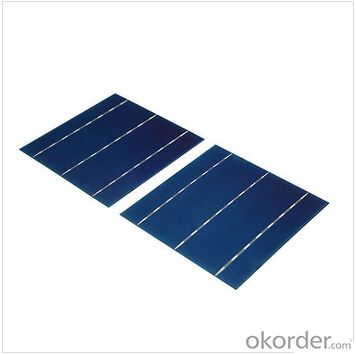
FAQ
We have organized several common questions for our clients,may help you sincerely:
①What price for each watt?
It depends on the efficiency of the solar cell, quantity, delivery date and payment terms.
②How long can we receive the product after purchase?
In the purchase of product within three working days, We will arrange the factory delivery as soon as possible. The pecific time of receiving is related to the state and position of customers.Commonly 7 to 10 working days can be served.
③Can you provide the peripheral products of the solar panels, such as the battery, controller, and inverter? If so, can you tell me how do they match each other?
Yes, we can, we have two companies for solar region, one is CNBM International, the other is CNBM engineering Co.
We can provide you not only the solar module but also the off grid solar system, we can also provide you service with on grid plant.
④What is your warranty of solar cell?
Our product can promise lower than 0.3% open box crack, we support claim after opening the box if it has crackm color difference or sth, the buyer should give pictures immediately, we can not accept the claim after the solar cell has assembled to solar panel.
• Timeliness of delivery
• ⑤How do you pack your products?
We have rich experience on how to pack the solar cell to make sure the safety on shipment, we could use wooden box or pallet as buyer's preference.
Uses of solar cells
Most Common Uses of Solar cells
In our modern society, we can acquire and utilize solar energy because of solar cells, and have enormous convenience for our life. Perhaps the most popular use of solar energy is one that doesn't involve technology at all: drying wet things. People around the world depend upon the sun to dry everything from laundry to crops. It's an effective way to achieve a goal without relying upon electricity.
It may seem unusual, but solar power has become a popular way to provide power to lighting systems that activate after the sun goes down. From street lights to garden lamps, solar power provides the energy needed to illuminate the darkness late into the night. These lights contain batteries that charge during the day as sunlight hits the solar cells. At night, a photo resistor detects the absence of light and a circuit board triggers the batteries to discharge and provide power to LED lights, which are efficient and bright
Uses of Solar cells in Daily Life
Hot water: Solar rooftop collectors use heat gathered from sunlight for hot water and building heat. These solar installations do not convert light into electricity; they use the sun’s heat to increase the temperature of water or another fluid flowing through pipes in the collector. The building then uses the hot water for swimming pools, showers, laundry and other applications. In many cases, the heating system has a traditional gas or electric utility connection that heats the water in case of prolonged cold temperatures or cloudy weather.
Calculators: Some desktop and pocket calculators have miniature solar panels built into them, providing energy to run the electronics inside. The solar panel runs on both sunlight and artificial lighting, such as incandescent and fluorescent bulbs. Solar-powered calculators typically have a “button” battery in addition to the solar panel, allowing their use in dimly-lit settings.
Road Signs: Small-scale solar power for lighting and other uses is handy because it avoids the need for gas-powered generators or wiring to an electrical outlet. A small solar panel provides enough power to light up a the stop signs or message boards used in construction work. Other types of solar-powered signs include speed limit signs and radar-driven speed warnings. The solar panel charges a battery so the sign continues to light up during nighttime hours.
- Q: How long does it take for solar cells to pay for themselves?
- The payback period for solar cells typically ranges from 5 to 10 years, depending on various factors such as the initial cost, energy consumption, and local solar incentives.
- Q: How do solar cells perform in low-light conditions?
- Solar cells perform less efficiently in low-light conditions compared to bright sunlight. The amount of electricity generated by solar cells is directly proportional to the intensity of light they receive. Therefore, in low-light conditions, such as during cloudy days or in shaded areas, solar cells produce less electricity. However, advancements in technology have improved the performance of solar cells in low-light conditions, enabling them to still generate some power even under these circumstances.
- Q: Can solar cells be used in railway applications?
- Yes, solar cells can be used in railway applications. They can be installed on railway tracks, train roofs, or station roofs to generate electricity and power various railway systems, such as signaling, lighting, and communication systems. Additionally, solar cells can also be used to charge batteries in trains or provide power for onboard equipment, reducing reliance on traditional sources of energy and promoting sustainability in the railway industry.
- Q: Can solar cells be used for powering water pumps?
- Yes, solar cells can be used for powering water pumps. Solar-powered water pumping systems utilize photovoltaic cells to convert sunlight into electricity, which can then be used to power water pumps. These systems are environmentally friendly, cost-effective, and reliable, making them a popular choice for remote areas or locations where grid electricity is not available.
- Q: How do solar cells perform in areas with high levels of light pollution?
- Solar cells do not perform as efficiently in areas with high levels of light pollution. The excessive artificial light can interfere with the ability of solar cells to absorb and convert sunlight into electricity. This results in reduced power output and lower overall performance of the solar cells.
- Q: Can solar cells be used to power refrigeration systems?
- Yes, solar cells can be used to power refrigeration systems. Solar cells convert sunlight into electricity, which can be used to power various appliances and systems, including refrigeration systems. This method of powering refrigeration systems is environmentally friendly and sustainable.
- Q: Can solar cells be used in residential applications?
- Yes, solar cells can be used in residential applications. In fact, they are increasingly being utilized in homes as a renewable and sustainable source of energy. Solar panels can be installed on rooftops or in yards to convert sunlight into electricity, reducing dependency on traditional power grids and lowering energy costs for homeowners.
- Q: Can solar cells be used in mining or extraction operations?
- Yes, solar cells can be used in mining or extraction operations. They can be employed to power various equipment and machinery used in these operations, such as lighting systems, ventilation systems, and pumps, reducing the reliance on fossil fuel-based energy sources. Additionally, solar cells can also be utilized to provide electricity to remote mining sites where grid connections are not feasible, thereby reducing the environmental impact and operational costs associated with these operations.
- Q: Can solar cells be used to power remote sensing devices?
- Yes, solar cells can be used to power remote sensing devices. Solar cells convert sunlight into electricity, providing a reliable and sustainable source of power for remote sensing devices in areas where traditional power sources may be unavailable or impractical. This enables continuous operation of these devices, allowing for data collection and monitoring in remote locations.
- Q: What is the impact of bird droppings or debris on solar cell performance?
- Bird droppings or debris can significantly impact the performance of solar cells. When bird droppings or debris accumulate on the surface of the solar panels, they can block sunlight from reaching the cells, reducing their efficiency. This shading effect can result in a decrease in electricity generation and overall output. Additionally, bird droppings contain corrosive substances that may damage the protective coatings on the solar panels, leading to long-term performance degradation. Therefore, regular cleaning and maintenance are essential to ensure optimal solar cell performance.
Send your message to us
Thin Film Photovoltaic Solar Cells - Polycrystalline Solar Cells Model:RSC-M156 Size:156mm
- Loading Port:
- Shanghai
- Payment Terms:
- TT or LC
- Min Order Qty:
- 3000 pc
- Supply Capability:
- 300000 pc/month
OKorder Service Pledge
OKorder Financial Service
Similar products
Hot products
Hot Searches
Related keywords
